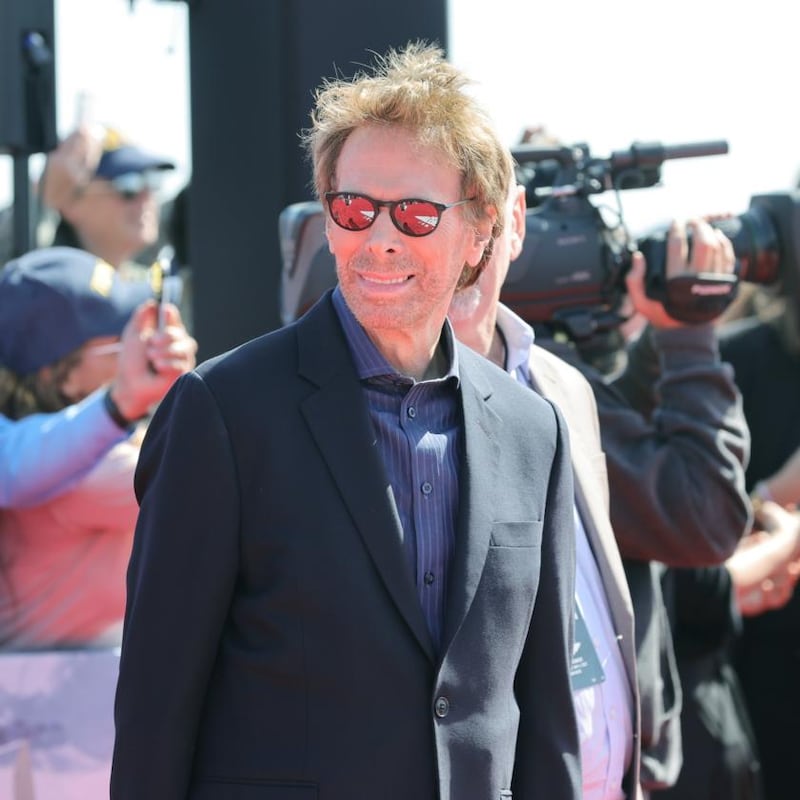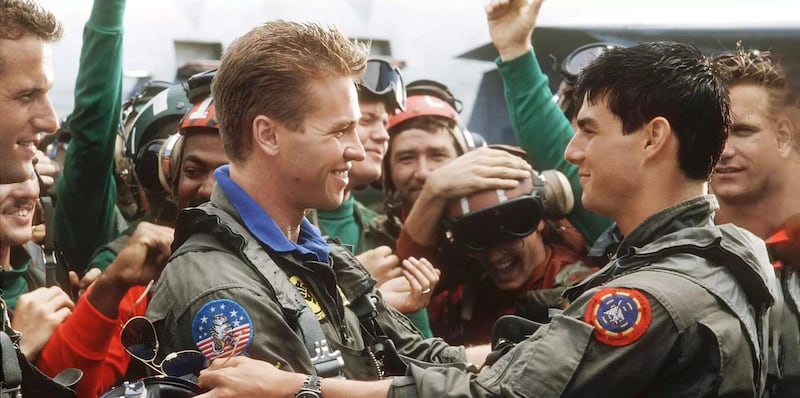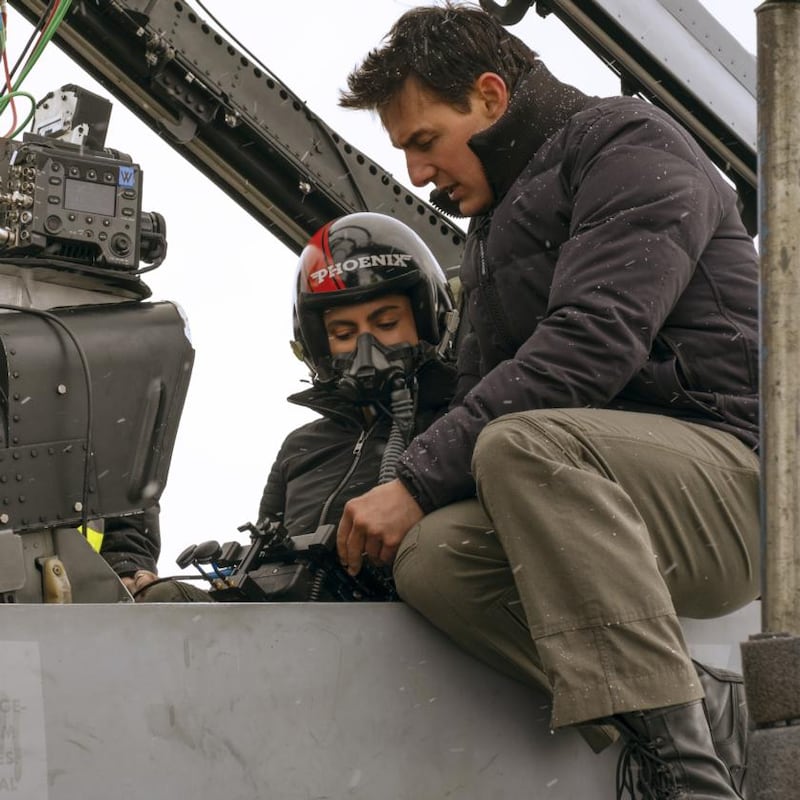It’s probably the most famous Quentin Tarantino monologue not featured in a Quentin Tarantino movie. In Sleep With Me, an otherwise forgettable 1994 romantic comedy featuring Eric Stoltz and Meg Tilly, Tarantino’s character moviesplains Top Gun at a party. Top Gun, he says, is really “a story about a man’s struggle with his own homosexuality”.
Here comes the missive: “You’ve got Maverick, all right? He’s on the edge, man . . . And you’ve got Iceman, and all his crew. They’re gay, they represent the gay man, all right? And they’re saying, go, go the gay way . . . He could go both ways . . . Kelly McGillis, she’s heterosexuality. She’s saying: no . . . go the normal way, play by the rules, go the normal way . . . That is what’s going on throughout that whole movie.”
When we made Top Gun, we had a preview in Houston and I'm telling you, there was no reaction whatsoever
The Pulp Fiction director wasn’t the first – or last – to pick up on that particular subtext. Writing in 5001 Nights at the Movies in 1991, the late critic Pauline Kael noted that whenever “. . . McGillis is offscreen, the movie is a shiny homoerotic commercial: the pilots strut around the locker room”.
Jerry Bruckheimer, Hollywood veteran and Top Gun producer, doesn’t mind that interpretation a bit. Any theory from Tarantino, he notes, is “a compliment”.
“It’s always interesting how various artists kind of pick up on things we did in the past,” he smiles. “I first met him through (Top Gun director) Tony Scott. In fact, Quentin did some writing for us on Crimson Tide. And the scenes he wrote for us were brilliant.”
More than three and a half decades ago, when Bruckheimer and his late producing partner Don Simpson premiered Top Gun – a movie in which a competitive young pilot with the callsign of Maverick (Tom Cruise), loses his best pal and wingman Goose (Anthony Edwards), reluctantly teams up with his former rival Iceman (Val Kilmer), and gets the girl named Charlie (Kelly McGillis) – they thought they had made a career-ending mistake. “I never know how an audience is going to accept our films,” says the producer behind such franchises as Bad Boys and Pirates of the Caribbean. “When we made Top Gun, we had a preview in Houston and I’m telling you, there was no reaction whatsoever. We thought we had the biggest flop in the world.
“But we didn’t realise it was the weekend that the shuttle crashed and it was Houston. There was an emotional numbness in the audience that they just couldn’t react to anything, But when we saw the cards, they were excellent. Then we got the reviews, which weren’t. So we still had no idea what we had. At least I didn’t. I had no idea this was something that was going to last 35 years or get talked about as being a classic.”
Top Gun: Maverick, a sequel some 36 years in the making, stars Tom Cruise as an unorthodox captain placed in charge of an elite group of Top Gun graduates for a specialised mission against an unidentified foe, at the behest of former rival, Iceman (Kilmer, again). Among the new recruits is Rooster (Miles Teller), the son of Maverick’s late best friend, Goose.
“When we first came out, of course, Paramount said, ‘oh, we have a big hit movie, we got to make a sequel, and can we make it cheaper?’” recalls Bruckheimer. “And no, that’s not how we work. But we did try to develop something and it never quite happened. So we all went on to other things. We made a whole bunch of movies.

“Maybe seven or eight years ago, we got more serious about it. We brought Joe Kasinski into it, and he came up with an idea that we all loved, and we took him to Paris where Tom had a 30-minute break in his Mission Impossible schedule. And Tom pulled out his phone and called the head of Paramount and said, ‘I’m making another Top Gun’. They were very happy to hear that.”
Original director Tony Scott’s suicide in 2012 delayed the already long-gestating production and shocked the core team of Cruise and Bruckheimer. “He had so much energy and love of life,” says Bruckheimer. “It’s unfortunate that it has happened. In fact Tom and myself were with Tony in Nevada on the weekend that he died. We were there on Friday. We were scouting and talking to Top Gun pilots. We flew home together, and I got a call on Sunday that he passed away. It was very sad and really a shock because he was very excited about making the movie.”
Directing duties passed to screenwriter Joseph Kosinski, who previously directed Tron: Legacy and Oblivion. But even after a complicated shoot, Covid got in the way of the original release date.
The last time we sat down with Jerry Brckheimer, he was attending a very ritzy premiere for Gemini Man in Budapest and pondering the contemporary difficulties of getting an original science fiction movie off the ground in an era of conveyor belt superheroes. Since that conversation, there’s been an industry-wide shutdown, and nothing like the hoopla of Budapest. Until now. After we finish our conversation today, Bruckheimer, Cruise and the entire team will make their way to Cannes for the world premiere of Top Gun: Maverick, and then back to London for additional red carpet duties.
It took us 15 months to figure out how to put six cameras in the cockpit
“I’ve missed it,” says Bruckheimer. “I missed making movies. And I’ve missed this part. The junkets and the publicity. People think you just make a film and you go away. That’s not true. This is part of the process of making movies.” As chronicled in David Sirota’s 2011 article for The Washington Post – 25 Years Later: How Top Gun Made America Love War – the 1986 hit, which was made with cooperation from the Pentagon, marked a turning point for America’s post-Vietnam military. The Navy capitalised on the film’s popularity by setting up recruitment tables at cinemas. While the project winged its way to an extraordinary $350 million in box office receipts – from a production budget of $15 million – it equally scared up a 500 per cent increase in applications to the United States aviation forces.
The sequel, unsurprisingly, was equally embedded with the military industrial complex. Bruckheimer worked with Lockheed Martin to design the fake Darkstar hypersonic aircraft that appears in the film. The effect was so realistic from space that China reportedly moved a spy satellite to photograph it. Meanwhile, combat-minded kids can enjoy 1/48 scale Top Gun plastic models, including an F-14A Tomcat inspired by the aircraft in the movie.
“It took us 15 months to figure out how to put six cameras in the cockpit,” says Bruckheimer. “We had a special camera made. We worked with the Navy technicians and pilots, asking: do you need this, do you need that? Because cameras meant taking stuff out of the plane. And then we had to go through the Navy lawyers and engineers so those cameras wouldn’t come loose.
“When we interviewed the actors for various parts, we said: we’re going to put you in a plane. We’re going to put you in an F-18. We had a number say: no chance. I’m not doing it. So the ones you see in the movie agreed up front that they were going to have to actually get in an F-18.
“Joe, the director, designed this programme where they start with a small prop plane and they get used to that. And then he put them in an aerobatic prop. And then, he put them in a jet where you feel more G-force. And finally in the F-18, where they felt seven times our body weight, like an elephant in your chest. When you’re watching the movie and you see those expressions on their face, that’s real.”

Bruckheimer is too much of a diplomat – and too experienced in a capricious industry – to count any of his former A-list collaborators out of the game.
Will Smith has had various heavy-hitting projects cancelled in the wake of his Oscars assault on Chris Rock, but Bruckheimer will only say that any future collaborations will be decided “higher up”. Ditto Johnny Depp whose dirty linen has been properly and publicly aired during his ongoing legal actions against former wife, Amber Heard.
Bruckheimer is currently developing future installments of Pirates of the Caribbean around Margot Robbie. There is no part for Johnny Depp “at this time”.
The Hollywood producer may be a poster boy for the genius of the system and the notion that most movie authorship resides with studios and big-budget producers rather than a visionary auteur. He still, however, values the old school idea of the movie star. “Tom is a good example of this,” says the producer. “He earned it, he deserves it. He works very hard at it. He lives his life like a professional athlete. The way he eats, how he sleeps, everything that he does is so he can make movies and be the actor that he wants to be. It’s all part of who he is.”
Back in 2019 as Top Gun Maverick’s casting was announced, Kelly McGillis, who was not asked back for the sequel, gave a moving interview about Hollywood and older women. “I’m old, and I’m fat, and I look age-appropriate for what my age is. And that is not what that whole scene is about,” she told Entertainment Tonight in 2019. (Jennifer Connelly replaces McGillis as Cruise’s love interest in the sequel; Meg Ryan, who also featured in the original cast, was not asked back either.)

“I didn’t hear the interview,” says Bruckheimer. “But Maverick’s character wouldn’t stay with somebody. He would move on because it’s not only him, it’s his life. The whole conversation he has in the bar with Penny (Jennifer Connelly’s character) about: you’re here and then you’re in Bahrain and you’re there. That’s who he is.” It’s not the most convincing answer but it’s hard to argue. In a business where, famously, nobody knows anything, Bruckheimer seems to know something at least.
It was his partner Don Simpson, who died in 1996 and who still appears in the opening credits of the Top Gun sequel, who popularised the idea of the high-concept movie during the 1980s. “He coined that phrase, I think. It’s simple: can you describe the movie in two sentences? That’s what it is. He’s still with me. He was quite a force in developing both our careers. We made a lot of fun movies for audiences.”
It’s interesting that Bruckheimer often cites audience appeal. His earliest film credits, including the revisionist western The Culpepper Cattle Company, Michael Mann’s Thief and Paul Schrader’s Cat People – point to a rather more arthouse path. “Well, it’s really interesting because those films weren’t thought of as that when I made them,” he says. “But over time, when you work with talented artisans, that happens. That’s what my career is built on. I’m standing on top of all these great directors and writers and actors.
“I try to find who’s the real talent. Hollywood is full of people who can talk the talk but can’t walk the walk. They can spin a tale but when you look at the work, you think: wait a second. So your job is to sift through all the people that can spin you a great tale and see the ones who really have a gift. And I’ve just been very fortunate to work with a lot of people who’ve had a great gift.”
Top Gun: Maverick opens May 25th




















